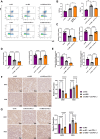UBD-mediated glycolytic reprogramming promotes M2 macrophage polarization in ovarian cancer immune evasion
- PMID: 40692714
- PMCID: PMC12278697
- DOI: 10.1002/ccs3.70034
UBD-mediated glycolytic reprogramming promotes M2 macrophage polarization in ovarian cancer immune evasion
Abstract
Ovarian cancer (OC) is one of the most common malignant tumors in women, with immunotherapy resistance (ITR) being a major challenge. Glycolytic metabolic reprogramming has been shown to play a crucial role in the tumor immune microenvironment and immune evasion, yet the underlying mechanisms remain unclear. This study aims to investigate the role of Ubiquitin D (UBD) in OC immunotherapy, particularly its regulation of macrophage polarization through glycolytic metabolism. Using data from the Cancer Genome Atlas and Clinical Proteomic Tumor Analysis Consortium databases, combined with proteomics techniques, we analyzed the expression of UBD in OC tissues and its correlation with key glycolytic enzymes. Through lentiviral-mediated gene manipulation and in vivo mouse models, we evaluated the effects of UBD on macrophage polarization, glycolytic metabolism, and immunotherapy. The results indicate that UBD promotes M2 macrophage polarization through glycolytic reprogramming, enhancing immune evasion and ITR in OC. Inhibiting UBD or targeting glycolytic pathways may provide new strategies for improving OC immunotherapy.
Keywords: glycolytic metabolism; immunotherapy resistance; macrophage polarization; ovarian cancer; tumor microenvironment; ubiquitin D.
© 2025 The Author(s). Journal of Cell Communication and Signaling published by John Wiley & Sons Ltd.
Conflict of interest statement
The authors declare no conflicts of interest.
Figures







Similar articles
-
TYROBP overexpression alters macrophage phenotype and enhances pancreatic cancer stemness through STAT3 and PKM2 signaling.Cell Signal. 2025 Oct;134:111949. doi: 10.1016/j.cellsig.2025.111949. Epub 2025 Jun 18. Cell Signal. 2025. PMID: 40553966
-
Liensinine reshapes the immune microenvironment and enhances immunotherapy by reprogramming metabolism through the AMPK-HIF-1α axis in hepatocellular carcinoma.J Exp Clin Cancer Res. 2025 Jul 15;44(1):208. doi: 10.1186/s13046-025-03477-6. J Exp Clin Cancer Res. 2025. PMID: 40665352 Free PMC article.
-
Ganoderic acid A regulates CSF1R to reprogram tumor-associated macrophages for immune therapy of hepatocellular carcinoma.Int Immunopharmacol. 2025 Aug 28;161:114989. doi: 10.1016/j.intimp.2025.114989. Epub 2025 Jun 7. Int Immunopharmacol. 2025. PMID: 40483831
-
Mitochondrial metabolic regulation of macrophage polarization in osteomyelitis and other orthopedic disorders: mechanisms and therapeutic opportunities.Front Cell Dev Biol. 2025 Jun 13;13:1604320. doi: 10.3389/fcell.2025.1604320. eCollection 2025. Front Cell Dev Biol. 2025. PMID: 40584964 Free PMC article. Review.
-
The Role of Immunotherapy and Immune Modulators in Hormone-Positive Breast Cancer: Implications for Localized and Metastatic Disease.J Clin Med. 2025 Jun 17;14(12):4322. doi: 10.3390/jcm14124322. J Clin Med. 2025. PMID: 40566067 Free PMC article. Review.
References
-
- Mazidimoradi, Afrooz , Momenimovahed Zohre, Allahqoli Leila, Tiznobaik Azita, Hajinasab Negar, Salehiniya Hamid, and Alkatout Ibrahim. 2022. “The Global, Regional and National Epidemiology, Incidence, Mortality, and Burden of Ovarian Cancer.” Health Science Reports 5(6). 10.1002/hsr2.936. - DOI - PMC - PubMed
-
- Hogen, Liat , Vicus Danielle, Ferguson Sarah Elizabeth, Gien Lilian T., Nofech‐Mozes Sharon, Lennox Genevieve K., and Bernardini Marcus Q.. 2019. “Patterns of Recurrence and Impact on Survival in Patients with Clear Cell Ovarian Carcinoma.” International Journal of Gynecological Cancer 29(7): 1164–1169. 10.1136/ijgc-2019-000287. - DOI - PubMed
LinkOut - more resources
Full Text Sources

